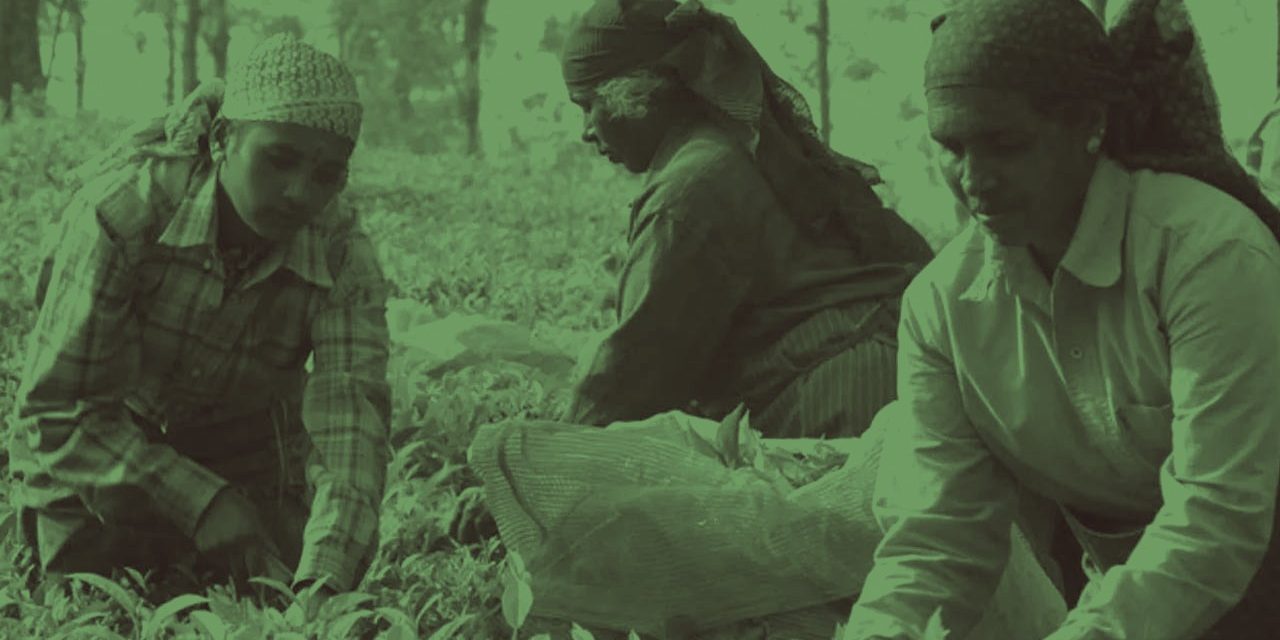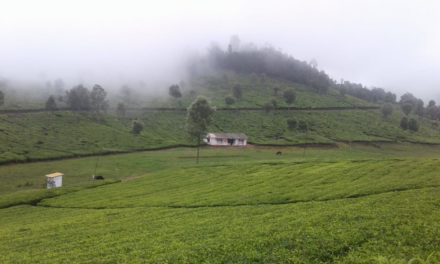In 2018, Cividep India and Finnwatch conducted a social sustainability study of tea consumed in Finland – by studying the working and living conditions of tea plantation workers in the Nilgiris from where this tea is sourced. A version of our report was published in a GLWC workshop in 2020 along with a benchmark amount of a monthly ‘living wage’ for tea workers. In this article, we discuss the meaning and need for ‘living wage’ calculations, critically analyze the various methodologies employed to arrive at a final figure, and compare this to the everyday ground realities of tea workers in the Nilgiris, their long term needs, and aspirations.
Nilgiris is a tea-growing region in the state of Tamil Nadu in southern India. A significant proportion of tea grown in the Nilgiris is destined for exports. In 2018, Finnwatch and Cividep conducted research in the Nilgiris on working and living conditions in the production of tea consumed in Finland. Our findings, which were published in 2019, spoke of a workforce that was putting in long hours and sacrificing their health for little return; and wanted a change.
Another related development was the Global Living Wage Coalition (GLWC) circulating its living wage benchmark for the rural Nilgiris tea sector in December 2020. Consequently, in the spring of 2020, our organizations were invited to participate in a GLWC living wage validation workshop. During this, a version of the Nilgiris living wage benchmark report was presented. Our written comments on the workshop are available here.
The monthly living wage benchmark for the rural Nilgiris tea sector put forward in the final GLWC report is INR 11,422 per person (or INR 12,666 in July 2020, adjusted for inflation). This figure assumes workers do not receive any in-kind benefits which the employer is still required to provide by law – although the laws that govern this are changing. If the worker does receive in-kind benefits, the value of the benefits is deducted from the living wage benchmark.
The benchmark is based on living cost calculations for a family of four of whom 1.73 are working and contributing towards family expenses. The reference family’s living costs are estimated as INR 17,116 per month (or INR 18,959 in July 2020, adjusted for inflation).
In the benchmark report, its authors suggest that in their view, this number is similar to that put forward previously by Finnwatch. However, Finnwatch and Cividep would like to clarify that our organisations have never calculated a living wage or the cost of living in the Nilgiris. At the time we were conducting the research for our report, it was already known that the GLWC was working on a living wage benchmark for the Nilgiris tea sector. As living wage calculations require considerable resources, it seemed unnecessary and beyond our means to duplicate this work. However, we did ask the tea workers whom we interviewed for our report what they thought they would need to earn to cover their living costs.
Workers’ responses varied greatly but came to an average of INR 16,000 per person. This would result in a considerably higher family income than that put forward in the GLWC benchmark report and needs to be considered in light of the definition of a living wage, methodology to calculate it, and its uses.
A living wage supports a basic but decent standard of living – but workers have other hopes too
In 2011, an ILO review of living wage descriptions, definitions and methodologies (conducted by Richard Anker, see below) established a consensus that a living wage is a wage that is sufficient to support a basic but decent standard of living for a family that is appropriate for a particular time and place. Other characteristics of a living wage on which there was common agreement already back then were that it does not require overtime, ensures sufficient disposable income, and improves with economic development.
The concept of a living wage is usually promoted as a human rights based alternative to a minimum wage which in many cases is not sufficient to afford an adequate standard of living. By definition, a living wage guarantees only a basic level of decency. This is also emphasized by the authors of the GLWC benchmark report who describe the living wage they have calculated as based on “conservative assumptions”, including government subsidized food prices.
Reading through the GLWC benchmark report makes it clear that keeping a family’s expenses within the budget that a living wage can afford would require every spending decision to be carefully considered and calculated. It can only be considered natural then that workers would themselves put forward a higher figure than what can be concluded through such stringent calculations. The question is, what do these different figures tell us and how should they be treated?
Different methodologies to calculate a living wage
Despite the broadly accepted consensus on a definition of a living wage, there is still not one but many ways to calculate it.
All GLWC living wage benchmarks are calculated using the methodology developed by Richard Anker and Martha Anker. Finnwatch supports the so-called Anker methodology as the most comprehensive and transparent methodology currently available to calculate a living wage. The methodology is based on a rigorous collection of data on food, housing, and non-food non-housing costs which are then paired with statistical information on family size and wage earners. Food costs are based on a model diet and housing costs on a housing standard. The non-food non-housing costs that are taken into account include education, health care, transportation, clothing, and a small provision for unexpected events.
The GLWC members are mostly certification schemes that commission living wage calculations as a means to address the gap between prevailing wages in the production of certified goods or produce, and a living wage. The Nilgiris living wage benchmark, for example, has been commissioned by Rainforest Alliance.
Another example of how a living wage can be calculated is the methodology developed by the Asia Floor Wage Alliance. The Asia Floor Wage methodology has been promoted in particular by trade unions and organisations active in the textile and garment sectors. Recently, the Clean Clothes Campaign published a living wage estimate for Central, East and South-East Europe based on a slightly adapted version of the Asia Floor Wage methodology.
The Asia Floor Wage methodology concentrates on food expenses from which the total living wage is then stipulated based on consideration of a range of factors such as family size. In the end and through collaboration between alliance members, a regional floor/living wage is provided to address not only wage levels at a certain location but also the relocation threat between countries and regions on wage. In 2020, the monthly living wage estimate put forward by the Asia Floor Wage Alliance in Indian currency was INR 29,323. This figure refers to an income necessary for a family of four, not wage per person. Cividep is a member of the Asia Floor Wage Alliance.
Workers’ expectations are rising and they want their children to escape plantation work; migrant labour fills the gap in the workforce
At the time we conducted our research in the Nilgiris, the workers we interviewed estimated that they earned between INR 4,000 – 9,000 per month or approximately INR 6,200 on average. Workers’ take-home pay varied greatly based on the number of days they had worked, personal wage deductions such as loan repayments, and performance-related issues such as the number of tea leaves they had plucked.
In addition to asking workers what they thought they should be paid to cover their living costs, we also asked them what they would be able to afford with that amount that they were not able to afford with their actual earnings at the time.
Workers’ responses varied from simply basic needs and a comfortable life without a crisis to ”good” food and savings for old age. Among the most common responses were their children’s wedding-related costs, and in some cases, payment of dowry. Although dowry is illegal in India, the tradition of the family of the bride being expected to pay considerable amounts in cash or in gifts to the family of the groom in the event of marriage is still very much alive. In some cases, women whose husband or in-laws consider the dowry her family has paid too low face violence and abuse, or even death. While dowry is a deep-rooted problem that goes far beyond the issue of a living wage, these responses from workers illustrate the significant financial pressures faced by many families. Several interviewees also mentioned having had to take loans for medical purposes. But the reason that the workers most commonly cited for their need for extra money were (vocational or higher) education for their children.
On education, the GLWC living wage benchmark takes into account primary and secondary education until around 15 years of age (i.e. compulsory education). In tea plantations, the assumption – and practice – has for long been that children ”inherit” their parents’ jobs and become tea workers themselves when they grow up. However, in the Nilgiris, this pattern appears to be breaking. Tea workers whom we spoke to seemed strong against their children taking up employment in tea gardens, and many were already funding their children’s vocational or higher schooling through loans. Life and work at tea plantations are hard, it takes its toll on workers’ health, and carries a stigma. In addition, the line houses where the plantation workforce can live free of charge as an in-kind component of their total remuneration, are often in poor shape. Indeed, the authors of the GLWC benchmark report found that none of the workers’ housing in the plantations that they visited met basic standards of decency, mainly due to their small size.
These are the conditions that the tea workers wish to move away from, or at least that their children would. Given all the hardship, they feel they are not adequately compensated for nor respected.
As the local workforce in tea plantations is declining, new workers are being engaged from some of India’s poorest states to work in the Nilgiris. In our research sample, migrant workers reported the highest earnings and were also the most satisfied with their current wage levels – even though they were regularly sending money back home and also unable to access certain benefits that the government provides, such as subsidized food rates.
Certification schemes must require, and buyers must commit, to the payment of a living wage
A living wage is a human right: no one should be earning less than a living wage for full-time work. This also means that a living wage is only a starting point, the lowest acceptable standard, and not the end goal. As such, it is unacceptable that neither of the major tea sustainability certification schemes present for example in the Finnish consumer market, Fairtrade, and Rainforest Alliance, require the payment of a living wage as minimum criteria that all certified producers must meet.
The recently revised Rainforest Alliance criteria, for example, only require certified producers to monitor the gap between the wages they pay and an applicable living wage estimate. If the actual wages are below a living wage, then they must be adjusted – but only at a minimum to keep up with inflation. This monitoring of wages includes information on working hours, for example, which is important as a living wage must be earned within standard working hours. But the information on actual hours workers put in should also come from workers themselves. Tea workers whom we interviewed for our report said that they often work 12 hours per day, 7 days a week during peak season – which is way more than the standard working week and even more than the legal limit in India.
Companies that are sourcing tea from the Nilgiris – or anywhere – should commit to the payment of (at least) a living wage to the workers in their supply chains. In India, tea sector wages are considerably lower in the Assam region, for example, than in the Nilgiris. Unilever, which owns the Lipton tea brand and many other consumer brands, has recently committed to the payment of a living wage to all workers in its supply chains by 2030. This needs to also be taken into account in the price that companies pay their suppliers for the tea. The price should be sufficient to cover the cost of sustainable production, including a living wage for all tea estate workers. In practice, this can be achieved through redistribution of margins in the tea value chain, or by raising consumer prices. Without addressing the wage issue in tea supply chains, tea cannot be sustainable.
Written by Aneesh Manjunath from Cividep India and Anu Kultalahti from Finnwatch.


